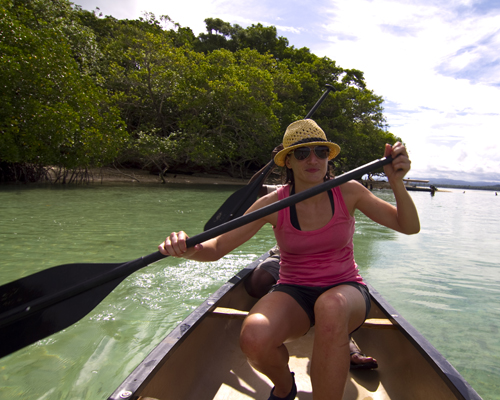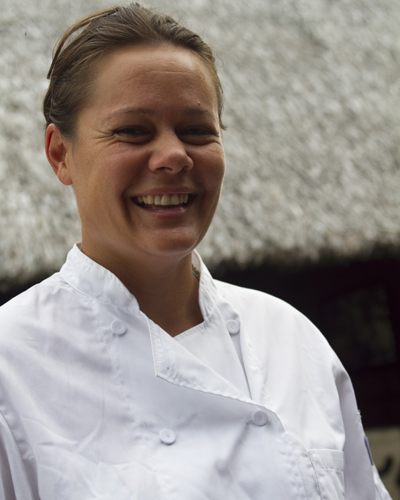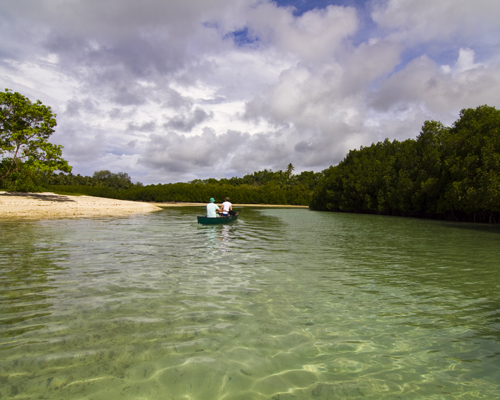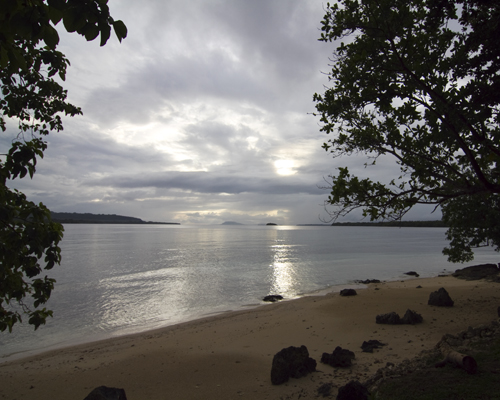
G paddling upriver to the blue hole on Malo Island. Photo by David Lansing.
I usually hate the rain, but it’s different here on Vanuatu. It’s warm and it’s comforting and there’s something about it that just connects me to the earth in a primitive way. It’s like the way my sense of smell is aroused by a smoky campfire or my taste buds ignited by bacon sizzling up on a cast-iron skillet outdoors. There is some DNA is our bodies that connects with the smell of fire, the taste of food cooked outdoors, and the feel of tropical rain.
Yesterday we were supposed to go on a day-long bush walk along a narrow jungle path across creeks and cascades and over a bamboo bridge to the Millennium Cave on Espiritu Santo, but in the morning, Frederick looked up at the rather gloomy sky and announced that the hike was off. “It is going to rain—hard,” he said, “and you’ll be up to your hips in mud.”
Instead, he suggested that if we timed it properly, we might be able to get in a canoe trip up an estuary on nearby Malo Island to a blue hole that, he said, was quite beautiful. Now, usually when I think of blue holes I think of the great vertical submarine caves off the coast of Belize or Dean’s Blue Hole in the Bahamas which were formed back in the Ice Ages when the ocean was 300 to 400 feet lower than it is now and these limestone depressions were formed from rain and chemical reactions and then, eventually, filled by the ocean.
That’s not what the Malo Blue Hole is. It’s simply a swimming hole far back in the jungle where a freshwater underground spring meets the ocean. The result is that the water is a brilliant cerulean. Thus the blue hole moniker.
So late in the afternoon, after we’d gotten one of those long, warm tropical showers that lasted for no more than twenty minutes before the skies cleared, we hoped into one of the resort’s motorboats and Amos took us over to Malo where several canoes were pulled up on the sand where the estuary empties out into the ocean.
Now, here’s the thing: We had three canoes and seven people plus Amos, our guide, so two of the canoes had three paddlers and one had two. Because I was bringing my camera gear and wanted to shoot photos as we rowed, I wanted to go with Amos and someone who could actually paddle a canoe while I shot pictures. The only problem with that is that it left the other two boats with mostly inexperienced paddlers. Which was a problem almost immediately. One boat, with three women, would either paddle into one of the other boats or, worse yet, straight into the shore.
“Don’t try and power it with your arms,” I thoughtfully yelled out to the women. “Use your core and your lower body. Paddle with your hips and your legs.”
“What the fuck do you think we’re doing!” replied Marguarite. Evidently she didn’t appreciate being stuck in a boat with two New Yorkers, neither of who had a clue as to what they were doing.
Meanwhile, my boat, guided by G and Amos, was doing fabulous, allowing me to sit comfortably in the front of the boat and take pictures, despite the fact that about every 15 seconds G would say something like, “Those guys in the other canoe are going to drown. We have to let Amos go with them and take one in our boat.”
Absolutely not, I told her. I’m shooting here. They’ll be fine. Just give them a few minutes to get the hang of it. Which is when the three women rowed straight into the concrete piling of a low bridge. Not good.
So G got her way. We all pulled up on to shore and a little mouse of a woman who looked absolutely terrified by her five or ten minutes on the water, got into the canoe with me and G while Amos gracefully slid into the other boat. And off we went.
There were howler monkeys screaming madly at us from the trees and legions of crocodiles sunning on the banks and when we came around one bend in the river, there was a rather frightening looking headhunter swinging two shrunken skulls at us and calling out that he had a special going today—two of his heads for one of ours.
I kid you, dear reader. I’m a kidder. There was none of that. In fact, the jungle was eerily silent. Like the calm before the storm. Also, it was getting rather dark. Very dark.
This estuary we were paddling up was shallow. In fact, every few minutes one or the other of us would ground their canoe and the occupants would have to carefully climb out, so as not to tip the boat over, and push or pull the craft over a sandbar. The two paddlers in one of the boats decided, after they’d both grounded their boat several times as well as flipped it, that it might just be easier to walk with the boat up the estuary, which is what they did.
Ah, but G and I and the nervous New York mouse navigated cleanly up the waterway, searching out the deep channels that often ran close to shore and avoiding any mishaps and after about an hour, we’d arrived at the blue hole. Which was a sort of milky azure color instead of the crystal clear cerulean I’d been expecting. But that was due, no doubt, to all the sediment-carrying rainfall feeding into the estuary. We tied the boats to mangroves and went for a swim. The water was much colder than the sea but not nearly as saline though, for some reason, it seemed heavy to me; like swimming with weights around your ankles.

The blue hole on Malo. Photo by David Lansing.
After about half an hour, the rain that had been threatening for some time started to come down. Not heavy, not intense; just small rain. But you could tell it was going to get worse. Which was a problem for me since I had stupidly not brought any protection for the backpack holding my camera gear other than the towel that I now wrapped around it like a turban.
We got into the canoes and, ignoring the others, G and I paddled quickly and silently. We had, on the trip up river, gotten into sync and now could sense when to switch sides paddling or let the other paddle left or right to maneuver us without the need to say anything. It felt splendid. Still, I was worried about the rain and my camera.
At one point the river narrowed to no more than ten feet with mangroves reaching out from both banks like zombie arms. Which is when I made a tragic mistake. I spoke to the New York mouse, sitting trembling with her hands in her lap as G and I did all the work, to watch out for the branch coming up on the right. Which is when she rolled hard to the left. And the canoe and G and I rolled with her.
What did I think as my backpack with a Canon 7D, four lenses, six filters, card reader, and numerous (spent) memory cards went underwater?
Just one word and it begins with an F. In fact, I thought that word three or four times. As in, F—, F—, F—, F—.
And then I was swimming to the surface and watching as my camera bag floated in the current away from me. Not good, I mumbled, or maybe it was more F—, F—, F—. It’s hard to remember. Suffice it to say that I was not a happy camper. But forget about that. I needed to quickly swim after my bag before the current claimed it.
To be continued…










Recent Comments